Katey Schultz's Blog, page 9
April 28, 2015
Revising the Novel: Printing the Pages
Writing is a physical act; it is three-dimensional. It can't be limited to the distance between eyes to screen, fingertips to keyboard. It can't be limited to the space between notepad and pen. When push comes to shove--or more appropriately, when deadline comes to call--one of my most anticipated stages of revision involves printing the pages and holding them in my hands.
Starting Tuesday morning, I begin my first read-aloud of this fourth revision of the novel. To be clear--I've printed certain chapters of this draft and read them out loud before. But I haven't had a complete draft, beginning to end, located in the same Word document and pressed "print" for over 200 pages in quite some time. I know the last four chapters, in particular, need major attention. Even still; I've come this far and I'm excited!
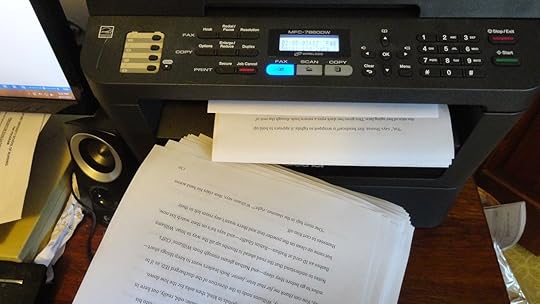
The concentration required by this part of the revision process is visceral. I shut my office door. I disconnect the wi-fi. I pace the room and hold each page like a fragile object. Once I've studied its contents, that fragility fades and is replaced by one of two things. The page either starts to feel firm, finished, and ready...or it feels loose, open, and waiting. If it's the former, I'll set it aside. If it's the latter, I'll walk to the desk, hunch over the page with my blue Pilot G-2 in hand, and do the good work of sentence surgery. If several pages in a row require this level of attention to right themselves, I'll grab my clipboard, sit in the recliner (not at the desk--this is important; if I want to think differently, I have to sit differently), and ponder what's not working and why.
Sometimes an answer comes immediately. A few swift changes, a few cuts, or a note to myself to fix something in a later chapter--and voila, I can move on. Other times, an answer takes hours, days, or longer. A good, long walk can help. So can making a batch of homemade hummus. These things distract my mind and let the subconscious do its work. Then I can return to the same section and begin reading aloud again.
What am I listening for? Something that's not true. Something that isn't earned. Something that's trying to do too much. Something that doesn't mean what it says. There's always a crack in these places; a muffled message, a snag in the line. If I'm careful enough, I'll hear it. If I've honed my imagination enough, I'll be able to hold these places up to the light and decipher my way through, illuminating the blind spots one syllable at a time.
Starting Tuesday morning, I begin my first read-aloud of this fourth revision of the novel. To be clear--I've printed certain chapters of this draft and read them out loud before. But I haven't had a complete draft, beginning to end, located in the same Word document and pressed "print" for over 200 pages in quite some time. I know the last four chapters, in particular, need major attention. Even still; I've come this far and I'm excited!

The concentration required by this part of the revision process is visceral. I shut my office door. I disconnect the wi-fi. I pace the room and hold each page like a fragile object. Once I've studied its contents, that fragility fades and is replaced by one of two things. The page either starts to feel firm, finished, and ready...or it feels loose, open, and waiting. If it's the former, I'll set it aside. If it's the latter, I'll walk to the desk, hunch over the page with my blue Pilot G-2 in hand, and do the good work of sentence surgery. If several pages in a row require this level of attention to right themselves, I'll grab my clipboard, sit in the recliner (not at the desk--this is important; if I want to think differently, I have to sit differently), and ponder what's not working and why.
Sometimes an answer comes immediately. A few swift changes, a few cuts, or a note to myself to fix something in a later chapter--and voila, I can move on. Other times, an answer takes hours, days, or longer. A good, long walk can help. So can making a batch of homemade hummus. These things distract my mind and let the subconscious do its work. Then I can return to the same section and begin reading aloud again.
What am I listening for? Something that's not true. Something that isn't earned. Something that's trying to do too much. Something that doesn't mean what it says. There's always a crack in these places; a muffled message, a snag in the line. If I'm careful enough, I'll hear it. If I've honed my imagination enough, I'll be able to hold these places up to the light and decipher my way through, illuminating the blind spots one syllable at a time.
Published on April 28, 2015 05:00
April 23, 2015
Jogging Writer: No Sprain, No Gain?
It finally happened. I'm running along, happy as can be, and the goats are up on the hillside doing their goat thing. They meeaa-aa-aa at me. I meeaa-aa-aa back at them. Around the far side of the barn, I see Bang Bang, one of two billy goats on this particular farm I run past. He's aptly named, but not for the typical goat behavior of ramming into things, rather, for his two distinctly curled, blond tufts of hair that arc like styled bangs over his big, batty eyelashes. Yes, Bang Bang is named for his hair.
"Hey Bang Bang!" I shout. Goats have facial recognition. I love this fact. "How's it goin'?" I ask. And that's when my foot falls down on the pavement. But not the pavement exactly, more like that awful edge where the pavement ends and the grass starts. On this particular curve, the height difference between the two surfaces is nearly two inches...enough to make me roll my left ankle fully, stumble for several steps, nearly fall to the ground, then regain balance.
How bad it is? I run a few more paces to gauge and I can't tell. Experience has taught me that "no pain" means "masked pain" and so, although every cell that ever played sports or trained hard is telling me to go-go-go, I stop. Look up at the sky. Let out a growling yelp of exasperation, and turn around.
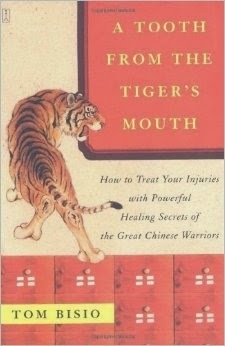 Up on the hillside, Bang Bang comes around the other side of the barn. Spring-green grasses trail from his mouth, tangled in a prize branch. I look away, mournful. Already, I've gone to a dark place. Already, I've leapt to conclusions--no training for months, pounds of weight gain, permanent chair-butt. I have experienced so many foot and ankle injuries in my life, I know this dark place well. It lacks the voice of reason. It's a well of stagnation. And it's horrible for my writing, too.
Up on the hillside, Bang Bang comes around the other side of the barn. Spring-green grasses trail from his mouth, tangled in a prize branch. I look away, mournful. Already, I've gone to a dark place. Already, I've leapt to conclusions--no training for months, pounds of weight gain, permanent chair-butt. I have experienced so many foot and ankle injuries in my life, I know this dark place well. It lacks the voice of reason. It's a well of stagnation. And it's horrible for my writing, too.
I limp back to the car, stumble into the house, and eat two pieces of gluten-free cake left over from my Bridal Shower. I lick the plate. The cats stare at me, an inanimate object in the kitchen. That's when it hits me--I haven't stopped. It's two weeks until the wedding and I've been go-go-go. I'm trying to work ahead so that my time off can be fully covered. I'm trying to finish the novel, too. I'm trying to journal and meditate and schedule massages and do it all right. But in my hustle, I've been doing something wrong.
Within a few hours, I'm clear-headed enough to see there's not much swelling around the ankle joint and bruising is unlikely. I treat it according to Tom Bisio's Chinese medicine approach for sports injuries, a text that has saved me many times before. I rest. I elevate. I use moxibustion and trauma liniment. I call Shihan Baker and tell him I can't come to class--weight bearing is too painful, let alone rapid movement--and he calls me off Mercy Me Hill anyway, saying he has a salve for injuries that increases healing time. Brad takes me to town, I bow into the dojo and to my teacher, he dabs the ankle, and I go back home.
For the next two days, I try hard to ignore email. I try not to overeat, but fail. I forgive myself. I eat some more. I don't forgive myself. But through it all, I've finally pushed through the dialogue scene in Chapter 17 of the novel. I've figured out how to deal with the flashback in Chapter 18. I've fully revised Chapter 19. And although every page I've touched will need to be looked at again, this is still something I can call progress.
Or maybe slowing down is a better word for it.
Brad brings me flowers in a vase. He sings me ridiculous, rhyming songs about ridiculous things. The cats sleep on my lap. I watch a movie. I watch another movie. (This happens approximately once ever 24 months...a big deal!) By the end of the week I'm walking with a bit more ease. There's still a limp. Still pain. But I'm here. I'm breathing. I'm slowing down.
"Hey Bang Bang!" I shout. Goats have facial recognition. I love this fact. "How's it goin'?" I ask. And that's when my foot falls down on the pavement. But not the pavement exactly, more like that awful edge where the pavement ends and the grass starts. On this particular curve, the height difference between the two surfaces is nearly two inches...enough to make me roll my left ankle fully, stumble for several steps, nearly fall to the ground, then regain balance.
How bad it is? I run a few more paces to gauge and I can't tell. Experience has taught me that "no pain" means "masked pain" and so, although every cell that ever played sports or trained hard is telling me to go-go-go, I stop. Look up at the sky. Let out a growling yelp of exasperation, and turn around.
 Up on the hillside, Bang Bang comes around the other side of the barn. Spring-green grasses trail from his mouth, tangled in a prize branch. I look away, mournful. Already, I've gone to a dark place. Already, I've leapt to conclusions--no training for months, pounds of weight gain, permanent chair-butt. I have experienced so many foot and ankle injuries in my life, I know this dark place well. It lacks the voice of reason. It's a well of stagnation. And it's horrible for my writing, too.
Up on the hillside, Bang Bang comes around the other side of the barn. Spring-green grasses trail from his mouth, tangled in a prize branch. I look away, mournful. Already, I've gone to a dark place. Already, I've leapt to conclusions--no training for months, pounds of weight gain, permanent chair-butt. I have experienced so many foot and ankle injuries in my life, I know this dark place well. It lacks the voice of reason. It's a well of stagnation. And it's horrible for my writing, too.I limp back to the car, stumble into the house, and eat two pieces of gluten-free cake left over from my Bridal Shower. I lick the plate. The cats stare at me, an inanimate object in the kitchen. That's when it hits me--I haven't stopped. It's two weeks until the wedding and I've been go-go-go. I'm trying to work ahead so that my time off can be fully covered. I'm trying to finish the novel, too. I'm trying to journal and meditate and schedule massages and do it all right. But in my hustle, I've been doing something wrong.
Within a few hours, I'm clear-headed enough to see there's not much swelling around the ankle joint and bruising is unlikely. I treat it according to Tom Bisio's Chinese medicine approach for sports injuries, a text that has saved me many times before. I rest. I elevate. I use moxibustion and trauma liniment. I call Shihan Baker and tell him I can't come to class--weight bearing is too painful, let alone rapid movement--and he calls me off Mercy Me Hill anyway, saying he has a salve for injuries that increases healing time. Brad takes me to town, I bow into the dojo and to my teacher, he dabs the ankle, and I go back home.
For the next two days, I try hard to ignore email. I try not to overeat, but fail. I forgive myself. I eat some more. I don't forgive myself. But through it all, I've finally pushed through the dialogue scene in Chapter 17 of the novel. I've figured out how to deal with the flashback in Chapter 18. I've fully revised Chapter 19. And although every page I've touched will need to be looked at again, this is still something I can call progress.
Or maybe slowing down is a better word for it.
Brad brings me flowers in a vase. He sings me ridiculous, rhyming songs about ridiculous things. The cats sleep on my lap. I watch a movie. I watch another movie. (This happens approximately once ever 24 months...a big deal!) By the end of the week I'm walking with a bit more ease. There's still a limp. Still pain. But I'm here. I'm breathing. I'm slowing down.
Published on April 23, 2015 05:00
April 21, 2015
Revising the Novel: The Comfort of 1st Person
I have written about 170 pages of the 4th revision of my novel and put about 3 years of work into the project as a whole. If I had to guess, I'd say that about 40-50 pages need to be written to get to the conclusion of the book. My aspiration is to get that done by the first week of May, when the manuscript is due to an editor I've hired. But in my naivete, I failed to understand the amount of time wedding prep would take (and Mom is doing most of it!). That, plus travel, scattered my mind more than I prefer.
All this being said, I was able to make five small additions to the novel last week that I hope make it through to the final version. While I've been writing in limited 3rd person point of view for every single chapter--sometimes focused on the American soldier Nathan, other times focused on the Afghan characters Aaseya or Rahim--this hasn't come easily to me. Much of Flashes of War is, in fact, 1st person and involves only momentary scenes or clips of narrative. The exhaustive focus and exhale of a 3rd person novel length is humbling.
The additions came in the form of a peripheral character named Shanaz. She's an old Afghan woman who has made a dire mistake. She's devout, stubborn, uneducated, and speaks her mind. I've known this about her all along, though she only appeared for one chapter in the early drafts of the book. She is mentione--without appearing--about 4 times, though, because Aaseya has to walk past Shanaz's house en route to the bazaar. In my new rendering of this woman, each time Aaseya walks past, Shanaz sees her and shouts something or glares. This provides a much more realistic rendering of Shanaz later, in the chapter where she fully appears as the focus of the action.
I thought about the changes I had made and knew I was heading the right direction, but something hadn't fully clicked. I still felt I needed to build up to Shanaz's chapter somehow, and I had some backstory about her that could increase tension in the novel, but Aaseya wasn't aware of it so I didn't know to include it without a point of view violation.
How to get that information into the story?
1st person flashes, of course! Thanks to author and friend Abigail DeWitt, who I meet with monthly to trade chapters and talk shop, the backstory came out through conversation. As I spoke to Abigail at length, I realized how fully I knew Shanaz and her story--separate from the main thread of the novel--but confessed I didn't see any way to include it. Abigail suggested 1st person and my heart leapt at the thought. 1st person writing, fiction or nonfiction, is a "home place" for me. It flows more readily than any other point of view. Once I put my mind to it, I wrote five separate 1st person flashes in Shanaz's voice and positioned them between chapters of the novel to increase tension and slowly reveal a side story that will hopefully add a layer of meaning and entertainment for readers.
Now, back to the final chapters...onward, toward May!
All this being said, I was able to make five small additions to the novel last week that I hope make it through to the final version. While I've been writing in limited 3rd person point of view for every single chapter--sometimes focused on the American soldier Nathan, other times focused on the Afghan characters Aaseya or Rahim--this hasn't come easily to me. Much of Flashes of War is, in fact, 1st person and involves only momentary scenes or clips of narrative. The exhaustive focus and exhale of a 3rd person novel length is humbling.
The additions came in the form of a peripheral character named Shanaz. She's an old Afghan woman who has made a dire mistake. She's devout, stubborn, uneducated, and speaks her mind. I've known this about her all along, though she only appeared for one chapter in the early drafts of the book. She is mentione--without appearing--about 4 times, though, because Aaseya has to walk past Shanaz's house en route to the bazaar. In my new rendering of this woman, each time Aaseya walks past, Shanaz sees her and shouts something or glares. This provides a much more realistic rendering of Shanaz later, in the chapter where she fully appears as the focus of the action.
I thought about the changes I had made and knew I was heading the right direction, but something hadn't fully clicked. I still felt I needed to build up to Shanaz's chapter somehow, and I had some backstory about her that could increase tension in the novel, but Aaseya wasn't aware of it so I didn't know to include it without a point of view violation.
How to get that information into the story?
1st person flashes, of course! Thanks to author and friend Abigail DeWitt, who I meet with monthly to trade chapters and talk shop, the backstory came out through conversation. As I spoke to Abigail at length, I realized how fully I knew Shanaz and her story--separate from the main thread of the novel--but confessed I didn't see any way to include it. Abigail suggested 1st person and my heart leapt at the thought. 1st person writing, fiction or nonfiction, is a "home place" for me. It flows more readily than any other point of view. Once I put my mind to it, I wrote five separate 1st person flashes in Shanaz's voice and positioned them between chapters of the novel to increase tension and slowly reveal a side story that will hopefully add a layer of meaning and entertainment for readers.
Now, back to the final chapters...onward, toward May!
Published on April 21, 2015 05:00
April 17, 2015
Get Flashy in July
I'm pleased to announce that the next offering of my popular Weekly Flashes program will be this July. I'm taking sign-ups for this program right now, which involves 1 prompt (plus sample texts) per week for an entire month, and then feedback on each of your 4 pieces of flash writing. This program is for flash fiction or flash nonfiction writers and the prompts are varied, unique, and customized. Returning students won't get repeat prompts.
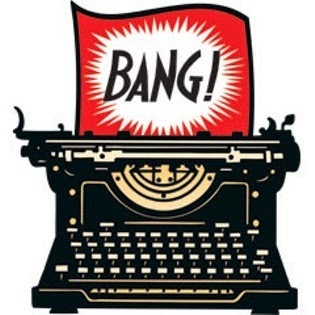 {source}How it works: In short, you get a prompt from me every Friday, have 1 week to respond, and then get feedback from me within a few days (and your next prompt a few days after that). We do this for one month and it establishes a fine balance between discipline, inspiration, accountability, and the habit of writing.
{source}How it works: In short, you get a prompt from me every Friday, have 1 week to respond, and then get feedback from me within a few days (and your next prompt a few days after that). We do this for one month and it establishes a fine balance between discipline, inspiration, accountability, and the habit of writing.
Bonus: This July, I'm adding a Google Hangout component at the end of the month where all Weekly Flashes participants will "sign in" for a live video reading, q&a, and celebration lasting about 1 hour.
Cost: $120. As of today, if you sign up and you bring a friend who is new to my services, you both get to register at a discounted rate of $100.
Next steps: Email me and state whether you're interested in flash fiction or flash nonfiction. Details about the program can be viewed in this handy PDF download.
More: Info on services from my Writer at Large business is right here.
 {source}How it works: In short, you get a prompt from me every Friday, have 1 week to respond, and then get feedback from me within a few days (and your next prompt a few days after that). We do this for one month and it establishes a fine balance between discipline, inspiration, accountability, and the habit of writing.
{source}How it works: In short, you get a prompt from me every Friday, have 1 week to respond, and then get feedback from me within a few days (and your next prompt a few days after that). We do this for one month and it establishes a fine balance between discipline, inspiration, accountability, and the habit of writing.Bonus: This July, I'm adding a Google Hangout component at the end of the month where all Weekly Flashes participants will "sign in" for a live video reading, q&a, and celebration lasting about 1 hour.
Cost: $120. As of today, if you sign up and you bring a friend who is new to my services, you both get to register at a discounted rate of $100.
Next steps: Email me and state whether you're interested in flash fiction or flash nonfiction. Details about the program can be viewed in this handy PDF download.
More: Info on services from my Writer at Large business is right here.
Published on April 17, 2015 05:00
April 14, 2015
War Lit Wrap-Up at #AWP15
#AWP15 was a whirlwind in the best possible ways, as I found myself in a family of more than 30 war lit authors, veteran authors, veteran bloggers, and veteran teachers. In contrast to Seattle's AWP, which was great for connecting with my PacNW crew but horrible for women war lit authors, this year felt like one, gigantic bear hug.
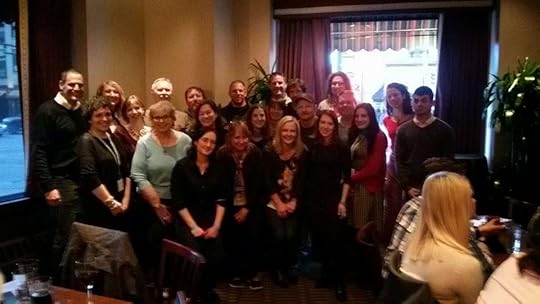 Author, veteran, and former West Point Professor (now at Rutgers) Peter Molin organized this war lit authors dinner. A pretty happy bunch, eh? Peter blogs at Time Now and it's worth the read. He'll be posting a discussion of the #AWP15 war lit panels soon. Bonus: the adorable blond at front/center is Siobhan Fallon (You Know When the Men Are Gone), who came all the way from Abu Dhabi to be on a panel with me and who also blogged about war lit.
Author, veteran, and former West Point Professor (now at Rutgers) Peter Molin organized this war lit authors dinner. A pretty happy bunch, eh? Peter blogs at Time Now and it's worth the read. He'll be posting a discussion of the #AWP15 war lit panels soon. Bonus: the adorable blond at front/center is Siobhan Fallon (You Know When the Men Are Gone), who came all the way from Abu Dhabi to be on a panel with me and who also blogged about war lit.
A few other folks have been blogging about their experiences, and author Christopher Meeks published his summary of the war lit panels he attended in great detail. Conversations touched on authenticity, authority, trauma, beauty, imagination, research, craft, and radical empathy. Read his full blog post here.
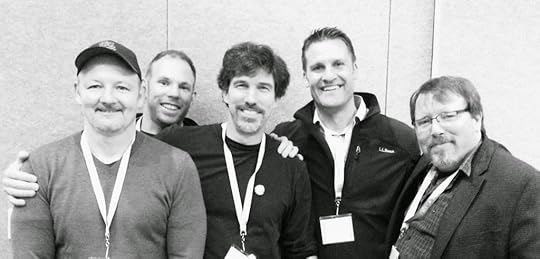 An incredible bunch, left to right: James A. Moad II (who has been instrumental in getting Veteran Voices Month written into the MN State Legislature), nonfiction writer Brandon Lingle whose pub list reads like a dream come true, the one and only Benjamin Busch (Dust to Dust, The Wire, Generation Kill), Jesse Goolsby (whose novel
I'd Walk with My Friends if I Could Find Them
hits stands this June), and the ever-gracious Brian Turner.
An incredible bunch, left to right: James A. Moad II (who has been instrumental in getting Veteran Voices Month written into the MN State Legislature), nonfiction writer Brandon Lingle whose pub list reads like a dream come true, the one and only Benjamin Busch (Dust to Dust, The Wire, Generation Kill), Jesse Goolsby (whose novel
I'd Walk with My Friends if I Could Find Them
hits stands this June), and the ever-gracious Brian Turner.
It's hard not to get a little glossy-eyed looking a photo of fellas like this. Flashes of War could have gone wrong in so many ways. Having people like these five gentlemen in my life means that it did not. In fact, their openness and kind praise has helped me feel more connected and welcomed by the veteran community than I ever would have imagined. I'm lucky, and can only hope the work I'm doing on the novel now will live up to the expectations of these people who I have so come to adore. And speaking of adore...
 The "Women Writing War" panel organized by author Emily Tedrowe made a great showing and had about 80 folks in the audience. My sincerest regret is that there weren't any female veterans on our panel. But our conversation was not intended to represent those voices, rather, to contemplate what it means to be a woman writing about war. We touched on interactions with the public, as well as ideas of identity and authority. Female veteran writers such as Jerri Bell (
O Dark Thirty
editor), Kayla Williams (Love My Rifle More than You), and Teresa Fazio were in the audience. I would have given up my seat, my microphone, and my best set of shoes to hear their thoughts on this topic.Over the years, I've learned that the true spirit of AWP is to further the conversation--whether we're talking about similes and sensory detail, about independent presses, or about war lit and authenticity. Indeed, the two panels I served on were sparked because of gaps in previous years' proposals. In coming years, I suspect we'll see a panel of women veteran authors and a panel of male military spouses, and perhaps even a panel of publishers revealing the hard truths and critical questions they have to field when publishing war lit in particular.
The "Women Writing War" panel organized by author Emily Tedrowe made a great showing and had about 80 folks in the audience. My sincerest regret is that there weren't any female veterans on our panel. But our conversation was not intended to represent those voices, rather, to contemplate what it means to be a woman writing about war. We touched on interactions with the public, as well as ideas of identity and authority. Female veteran writers such as Jerri Bell (
O Dark Thirty
editor), Kayla Williams (Love My Rifle More than You), and Teresa Fazio were in the audience. I would have given up my seat, my microphone, and my best set of shoes to hear their thoughts on this topic.Over the years, I've learned that the true spirit of AWP is to further the conversation--whether we're talking about similes and sensory detail, about independent presses, or about war lit and authenticity. Indeed, the two panels I served on were sparked because of gaps in previous years' proposals. In coming years, I suspect we'll see a panel of women veteran authors and a panel of male military spouses, and perhaps even a panel of publishers revealing the hard truths and critical questions they have to field when publishing war lit in particular.
Meantime, if you're inspired by what's happening in this crucial field of literature, please enjoy any of the above links for more information about the movers and shakers of war lit right now. These are people who've paved the way for me, and I couldn't be more grateful.
 Author, veteran, and former West Point Professor (now at Rutgers) Peter Molin organized this war lit authors dinner. A pretty happy bunch, eh? Peter blogs at Time Now and it's worth the read. He'll be posting a discussion of the #AWP15 war lit panels soon. Bonus: the adorable blond at front/center is Siobhan Fallon (You Know When the Men Are Gone), who came all the way from Abu Dhabi to be on a panel with me and who also blogged about war lit.
Author, veteran, and former West Point Professor (now at Rutgers) Peter Molin organized this war lit authors dinner. A pretty happy bunch, eh? Peter blogs at Time Now and it's worth the read. He'll be posting a discussion of the #AWP15 war lit panels soon. Bonus: the adorable blond at front/center is Siobhan Fallon (You Know When the Men Are Gone), who came all the way from Abu Dhabi to be on a panel with me and who also blogged about war lit.A few other folks have been blogging about their experiences, and author Christopher Meeks published his summary of the war lit panels he attended in great detail. Conversations touched on authenticity, authority, trauma, beauty, imagination, research, craft, and radical empathy. Read his full blog post here.
 An incredible bunch, left to right: James A. Moad II (who has been instrumental in getting Veteran Voices Month written into the MN State Legislature), nonfiction writer Brandon Lingle whose pub list reads like a dream come true, the one and only Benjamin Busch (Dust to Dust, The Wire, Generation Kill), Jesse Goolsby (whose novel
I'd Walk with My Friends if I Could Find Them
hits stands this June), and the ever-gracious Brian Turner.
An incredible bunch, left to right: James A. Moad II (who has been instrumental in getting Veteran Voices Month written into the MN State Legislature), nonfiction writer Brandon Lingle whose pub list reads like a dream come true, the one and only Benjamin Busch (Dust to Dust, The Wire, Generation Kill), Jesse Goolsby (whose novel
I'd Walk with My Friends if I Could Find Them
hits stands this June), and the ever-gracious Brian Turner.It's hard not to get a little glossy-eyed looking a photo of fellas like this. Flashes of War could have gone wrong in so many ways. Having people like these five gentlemen in my life means that it did not. In fact, their openness and kind praise has helped me feel more connected and welcomed by the veteran community than I ever would have imagined. I'm lucky, and can only hope the work I'm doing on the novel now will live up to the expectations of these people who I have so come to adore. And speaking of adore...
 The "Women Writing War" panel organized by author Emily Tedrowe made a great showing and had about 80 folks in the audience. My sincerest regret is that there weren't any female veterans on our panel. But our conversation was not intended to represent those voices, rather, to contemplate what it means to be a woman writing about war. We touched on interactions with the public, as well as ideas of identity and authority. Female veteran writers such as Jerri Bell (
O Dark Thirty
editor), Kayla Williams (Love My Rifle More than You), and Teresa Fazio were in the audience. I would have given up my seat, my microphone, and my best set of shoes to hear their thoughts on this topic.Over the years, I've learned that the true spirit of AWP is to further the conversation--whether we're talking about similes and sensory detail, about independent presses, or about war lit and authenticity. Indeed, the two panels I served on were sparked because of gaps in previous years' proposals. In coming years, I suspect we'll see a panel of women veteran authors and a panel of male military spouses, and perhaps even a panel of publishers revealing the hard truths and critical questions they have to field when publishing war lit in particular.
The "Women Writing War" panel organized by author Emily Tedrowe made a great showing and had about 80 folks in the audience. My sincerest regret is that there weren't any female veterans on our panel. But our conversation was not intended to represent those voices, rather, to contemplate what it means to be a woman writing about war. We touched on interactions with the public, as well as ideas of identity and authority. Female veteran writers such as Jerri Bell (
O Dark Thirty
editor), Kayla Williams (Love My Rifle More than You), and Teresa Fazio were in the audience. I would have given up my seat, my microphone, and my best set of shoes to hear their thoughts on this topic.Over the years, I've learned that the true spirit of AWP is to further the conversation--whether we're talking about similes and sensory detail, about independent presses, or about war lit and authenticity. Indeed, the two panels I served on were sparked because of gaps in previous years' proposals. In coming years, I suspect we'll see a panel of women veteran authors and a panel of male military spouses, and perhaps even a panel of publishers revealing the hard truths and critical questions they have to field when publishing war lit in particular.Meantime, if you're inspired by what's happening in this crucial field of literature, please enjoy any of the above links for more information about the movers and shakers of war lit right now. These are people who've paved the way for me, and I couldn't be more grateful.
Published on April 14, 2015 05:00
April 10, 2015
The Story Behind the Story
I recently learned that my flash fiction, "The Last Thing They Might Have Seen," was selected as a Finalist for
THE BEST SMALL FICTIONS 2015
--a powerful annual anthology made possible by series editor Tara Masih and publisher Queen's Ferry Press. I didn't even realize my writing was under consideration, and although my story wasn't a winner, I'm so pleased that my little short pieces are finding their way under the microscope of such judges as Robert Olen Butler. Considering that greats such as Stuart Dybek were among the winners, being named "finalist" surely makes my day!
"The Last Thing They Might Have Seen" has also been nominated for The Pushcart Prize and was published by KYSO Flash. Read the full story by using the link. Now, here's the story behind the story:
Friends in Appalachia may recognize tendrils of this story when they read it. That's because it's the only story I've written that was quite literally inspired by a newspaper article and local information. I never read the newspaper article at the time--I didn't subscribe, because I spent more time in a different county than the one that published the story--but local rumors filled my mind with sadness and wonder about the car accident. I never knew the men's names involved in the car accident in Mitchell County--where I lived and worked at the time--and that fact always bothered me. Who were they? What brought them here? The hispanic community is so vital to where we live in the Blue Ridge and yet, sadly, largely invisible. Even in death, these men weren't known. I hated that. I drove past the flowers on the road en route to work at Penland School of Crafts for so long, that I just couldn't ever let it go.
Several years later, the story came out of me. I originally set it on Highway 226 but that felt too close, too personal--like invading something that wasn't mine. So I moved it to the Ozarks. The idea for the mortician came to me when the first sentences of the story popped into my head while serving as Writer-in-Residence at Interlochen Arts Academy. The names of the men in the story, of course, are completely fabricated, as are all the details of their lives that I imagined. I'll never know the "true" story. Once my story was published and nominated for The Pushcart Prize, I sought out the newspaper article that I knew must have been printed around the time of the accident. Sure enough, I found it, published May 30, 2007:
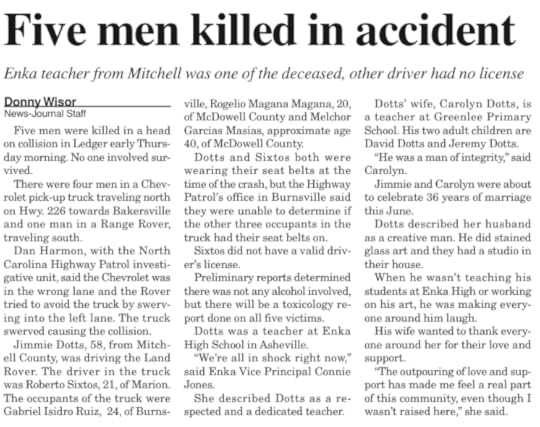
"The Last Thing They Might Have Seen" has also been nominated for The Pushcart Prize and was published by KYSO Flash. Read the full story by using the link. Now, here's the story behind the story:
Friends in Appalachia may recognize tendrils of this story when they read it. That's because it's the only story I've written that was quite literally inspired by a newspaper article and local information. I never read the newspaper article at the time--I didn't subscribe, because I spent more time in a different county than the one that published the story--but local rumors filled my mind with sadness and wonder about the car accident. I never knew the men's names involved in the car accident in Mitchell County--where I lived and worked at the time--and that fact always bothered me. Who were they? What brought them here? The hispanic community is so vital to where we live in the Blue Ridge and yet, sadly, largely invisible. Even in death, these men weren't known. I hated that. I drove past the flowers on the road en route to work at Penland School of Crafts for so long, that I just couldn't ever let it go.
Several years later, the story came out of me. I originally set it on Highway 226 but that felt too close, too personal--like invading something that wasn't mine. So I moved it to the Ozarks. The idea for the mortician came to me when the first sentences of the story popped into my head while serving as Writer-in-Residence at Interlochen Arts Academy. The names of the men in the story, of course, are completely fabricated, as are all the details of their lives that I imagined. I'll never know the "true" story. Once my story was published and nominated for The Pushcart Prize, I sought out the newspaper article that I knew must have been printed around the time of the accident. Sure enough, I found it, published May 30, 2007:

Published on April 10, 2015 05:00
April 7, 2015
War Lit at #AWP15
There's a first for everything. For me, that means this week I will be presenting on a panel of award-winning authors at the largest conference for writers in the world. While I've attended the annual Association of Writers & Writing Programs (AWP) conference several times before, this year I get to go in part because of grant-funding I was awarded from the North Carolina and Toe River Arts Councils. I also get to go because panel moderators Benjamin Busch and Emily Gray Tedrowe were kind enough to include my work in their presentation proposals.
 After exhausting myself with a self-funded book tour last year, I attended AWP with enthusiasm, hoping to connect with fellow war lit authors and meet writers who I had connected with via social media since the Flashes of War release. All that happened. But what also happened was I grew gravely disappointed in the narrowness of the war lit conversations at that year's conference, in addition to the small number of women and civilians invited to contribute to these conversations. I wasn't the only one who noticed the gap. Independent of each other, Ben and Emily wrote proposals for panels and invited me to join. Their proposals were accepted from a pool of thousands and here I am, packing for the Minneapolis Convention Center--this year's conference headquarters. Ben and I met in 2010 and even joined forces for part of my book tour. Emily and I have never met, but women war lit authors have a way of seeking each other out, and we've been connected through social media for quite some time.
After exhausting myself with a self-funded book tour last year, I attended AWP with enthusiasm, hoping to connect with fellow war lit authors and meet writers who I had connected with via social media since the Flashes of War release. All that happened. But what also happened was I grew gravely disappointed in the narrowness of the war lit conversations at that year's conference, in addition to the small number of women and civilians invited to contribute to these conversations. I wasn't the only one who noticed the gap. Independent of each other, Ben and Emily wrote proposals for panels and invited me to join. Their proposals were accepted from a pool of thousands and here I am, packing for the Minneapolis Convention Center--this year's conference headquarters. Ben and I met in 2010 and even joined forces for part of my book tour. Emily and I have never met, but women war lit authors have a way of seeking each other out, and we've been connected through social media for quite some time.
If you're in the area, please consider attending. Descriptions of my two panels are below, and following that I've provided a link for the full conference schedule as well.
Women Writing War
Room M100 F&G, Mezzanine Level, Thursday, April 9, 2015, 1:30 pm to 2:45 pm
Writing about her war-haunted novel Mrs. Dalloway, Virginia Woolf asks: Have I the power of conveying the true reality? Her question reflects many of the tensions in women’s war poetry, fiction, and nonfiction. How does gender disrupt conventional narratives of war? Do women tell different war stories? And how are issues of authority, credentials, and truth relevant to women currently writing about the conflicts in Afghanistan and Iraq? (Presenters: Emily Tedrowe, Jehanne Dubrow, Katey Schultz, Cara Hoffman)
Telling Our New War Stories: Witness and Imagination Across Literary GenresRoom 211 C&D, Level 2, Saturday, April 11, 2015, 1:30 pm to 2:45 pm It has been argued that credibility requires direct witness, that true war stories can only be told by those who have been there. The fact is that stories from Iraq and Afghanistan are arriving in all literary genres and from multiple perspectives, some using imagination to create equal truths. These five authors, writing through short fiction, essay, poetry, memoir, and nonfiction, will discuss how the fragmentary nature of the war narrative can be written from inside or outside the uniform.(Presenters: Benjamin Busch, Phil Klay, Siobhan Fallon, Brian Turner, Katey Schultz)
At least half a dozen other panels will address war, violence, or writing "the other" in fiction, memoir, and poetry, including such presenters and fellow author friends as Brian Castner, Kayla Williams, Peter Molin, Donald Anderson, Ron Capps, and more. View the full schedule here.
 After exhausting myself with a self-funded book tour last year, I attended AWP with enthusiasm, hoping to connect with fellow war lit authors and meet writers who I had connected with via social media since the Flashes of War release. All that happened. But what also happened was I grew gravely disappointed in the narrowness of the war lit conversations at that year's conference, in addition to the small number of women and civilians invited to contribute to these conversations. I wasn't the only one who noticed the gap. Independent of each other, Ben and Emily wrote proposals for panels and invited me to join. Their proposals were accepted from a pool of thousands and here I am, packing for the Minneapolis Convention Center--this year's conference headquarters. Ben and I met in 2010 and even joined forces for part of my book tour. Emily and I have never met, but women war lit authors have a way of seeking each other out, and we've been connected through social media for quite some time.
After exhausting myself with a self-funded book tour last year, I attended AWP with enthusiasm, hoping to connect with fellow war lit authors and meet writers who I had connected with via social media since the Flashes of War release. All that happened. But what also happened was I grew gravely disappointed in the narrowness of the war lit conversations at that year's conference, in addition to the small number of women and civilians invited to contribute to these conversations. I wasn't the only one who noticed the gap. Independent of each other, Ben and Emily wrote proposals for panels and invited me to join. Their proposals were accepted from a pool of thousands and here I am, packing for the Minneapolis Convention Center--this year's conference headquarters. Ben and I met in 2010 and even joined forces for part of my book tour. Emily and I have never met, but women war lit authors have a way of seeking each other out, and we've been connected through social media for quite some time. If you're in the area, please consider attending. Descriptions of my two panels are below, and following that I've provided a link for the full conference schedule as well.
Women Writing War
Room M100 F&G, Mezzanine Level, Thursday, April 9, 2015, 1:30 pm to 2:45 pm
Writing about her war-haunted novel Mrs. Dalloway, Virginia Woolf asks: Have I the power of conveying the true reality? Her question reflects many of the tensions in women’s war poetry, fiction, and nonfiction. How does gender disrupt conventional narratives of war? Do women tell different war stories? And how are issues of authority, credentials, and truth relevant to women currently writing about the conflicts in Afghanistan and Iraq? (Presenters: Emily Tedrowe, Jehanne Dubrow, Katey Schultz, Cara Hoffman)
Telling Our New War Stories: Witness and Imagination Across Literary GenresRoom 211 C&D, Level 2, Saturday, April 11, 2015, 1:30 pm to 2:45 pm It has been argued that credibility requires direct witness, that true war stories can only be told by those who have been there. The fact is that stories from Iraq and Afghanistan are arriving in all literary genres and from multiple perspectives, some using imagination to create equal truths. These five authors, writing through short fiction, essay, poetry, memoir, and nonfiction, will discuss how the fragmentary nature of the war narrative can be written from inside or outside the uniform.(Presenters: Benjamin Busch, Phil Klay, Siobhan Fallon, Brian Turner, Katey Schultz)
At least half a dozen other panels will address war, violence, or writing "the other" in fiction, memoir, and poetry, including such presenters and fellow author friends as Brian Castner, Kayla Williams, Peter Molin, Donald Anderson, Ron Capps, and more. View the full schedule here.
Published on April 07, 2015 05:00
April 3, 2015
Jogging Writer: Training Plan Between Races
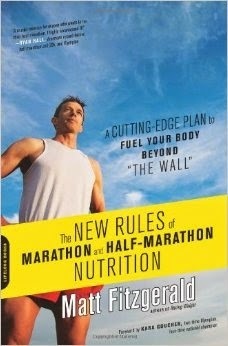 I ate whatever I wanted after the race. This included coconut milk ice cream and sweet potato fries. Today, I made a batch of gluten-free chocolate chip cookies. While I'm not one for strict dieting, and while I also feel pretty ok about my overall physical condition, I likewise know the path these enticing cookies head down. I'm not sure it's one I want to indulge for too terribly long.
I ate whatever I wanted after the race. This included coconut milk ice cream and sweet potato fries. Today, I made a batch of gluten-free chocolate chip cookies. While I'm not one for strict dieting, and while I also feel pretty ok about my overall physical condition, I likewise know the path these enticing cookies head down. I'm not sure it's one I want to indulge for too terribly long.Thankfully, Matt Fitzgerald's New Rules of Marathon and Half-Marathon Nutrition has a chapter that addresses nutrition and exercise recommendations for between races. From reading his earlier work, Racing Weight, I know that my ideal racing weight is 160 pounds and I burn about 1600 calories per day based on my body fat percentage and basal metabolic rate. This information is all I need in order to proceed with his "after race quick start" recommendations and, while I'm slightly burnt out on plans and programs, I've come too far to stop now.
So I've taken it easy this week, with just 2 workouts and three long walks. I've indulged (hence today's cookies and, forthcoming, Saturday's cake and champagne at my Bridal Shower). Starting Sunday, I'll shift gears. Quoting much of Fitzgerald's well-researched writings, here's how:
First, create a moderate calorie deficit: "For runners, a moderate calorie deficit is better than a large one...While building fitness may not be your top priority at this time, you're still working out and trying to lay a foundation for the race-focused training to come. Eating too little would sabotage these efforts. Also, if your calorie deficit is too large you will lose more muscle and less fat than you would with a moderate calorie deficit...If you're within 10 pounds of your racing weight, 300 calories is sufficient...enabling you to lose weight fairly quickly while preserving muscle mass."
Second, increase protein intake: "In a 2010 study conducted at the University of Birmingham England, two groups of athletes cut calories equally to promote weight loss. But one group got 15% of its daily calories from protein (which is about normal) while the other group bumped up its protein intake to 35%. The 15% group lost more total weight, but more than half of that weight was lean body mass. Members of the 35% protein group lost just as much fat without losing any muscle...I recommend you aim to get 30 percent of your total calories from protein during [this time]. Increasing your protein intake to this level will necessitate a commensurate reduction in carbohydrate consumption, but that's not a problem because your training load is relatively low and you are not pursuing maximum performance."
Third, lift weights: "First, it will give you a more solid musculoskeletal foundation to take into the next training cycle. In addition, much like increased protein intake, a bigger commitment to strength training [during this time] will help you retain muscle and shed only unwanted body fat...I encourage runners to perform three weekly full-body functional strength workouts...Weightlifting is preferable to other forms of strength training such as calisthenics and yoga because it builds more muscle and thereby promotes more fat loss."
Fourth, do fasting workouts: "Within a race-focused training cycle it is prudent to make every other week's longest run a 'fasting workout' where carbohydrate [ex. Gatorade] is withheld...but during [this time between race trainings] I recommend doing a long fasting run every week. Long runs undertaken at moderate intensity and without carbohydrate intake burn more fat than any other type of run you can do and thus contribute more to your goal of shedding excess body fat."
Fifth, do very short, very high-intensity intervals: "You can't maintain maximum training volume year-round or you'll burn out...So when your training volume is lower, as it is [during this time], you need to burn calories in alternative ways...High-intensity intervals contribute to fat loss by creating a huge post-workout fat-burning effect...I advise runners to perform one full interval workout plus a separate workout with a smaller amount of high-intensity running each week...You can get the strength, speed, power, and fat-loss benefits you seek from maximum-intensity running with less chance of injury if you sprint uphill instead [of sprinting on level ground]. Hill sprints (ten-second efforts) and hill intervals (twenty- or thirty-second efforts) are the two types of interval training I recommend for runners."
Putting it all together: "Monday--Strength workout. Tuesday--Easy run + hill sprints. Wednesday--Strength workout. Thursday--Hill intervals run. Friday--Strength workout. Saturday--Cycling power intervals. Sunday--Fasting run...Your workout should be quite manageable in the first week and then become gradually more challenging in subsequent weeks."
Published on April 03, 2015 05:00
March 31, 2015
Jogging Writer: First Half Marathon
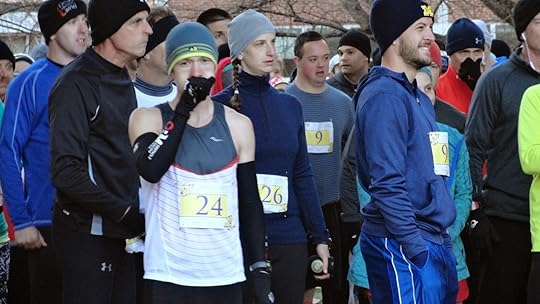 Bright and early in below freezing temps, we gathered for announcements before the race!After 6 months of training via Matt Fitzgerald's 80/20 Running principles, I'm happy to say I met my goal: I finished a Half Marathon. I raced the 5K in October, then a 10K in December, and--last weekend--my first Half Marathon in the Valley of the Lilies annual race at Western Carolina University. The course included a 1/2 mile uphill in Mile 5 and an unforgettably steep 3/4-mile long climb in Mile 11. The rest was rolling up and down along riverside backroad or campus pathways, with a few flat stretches thrown in for mercy.
Bright and early in below freezing temps, we gathered for announcements before the race!After 6 months of training via Matt Fitzgerald's 80/20 Running principles, I'm happy to say I met my goal: I finished a Half Marathon. I raced the 5K in October, then a 10K in December, and--last weekend--my first Half Marathon in the Valley of the Lilies annual race at Western Carolina University. The course included a 1/2 mile uphill in Mile 5 and an unforgettably steep 3/4-mile long climb in Mile 11. The rest was rolling up and down along riverside backroad or campus pathways, with a few flat stretches thrown in for mercy.Although temps were in the high sixties in Cullowhee, NC just a few days prior to the race, the high for race day was a mere 34 degrees. We gathered around 7:30am and the race kicked off at 8:00am, with temps in the twenties. Indeed, by the time the course closed and the awards ceremony began, despite the bright sunlight and clear skies, the temps held steady in the low thirties. There was even a dusting of snow from the night before, flakes still evident on one of the bridges we crossed. Although the wind was biting, I prefer to run on the cold than the heat, and most of my training was in the temps ranging from 30-40 degrees, so it wasn't the weather that intimidated me.
What did intimidate me? I'm not sure that anything did, actually, though that's not to say I didn't have my share of butterflies in my stomach. Inconveniently, I started my period 2 hours before the race. Once that happened, all nervousness left me. I understood immediately that there were going to be physiological forces beyond my control that impacted the race. I let any longing for control over the race results go, and just decided I was going to try my best--whatever "best" looked like for that day, those conditions. While I had hoped to come in around 2hr17min, I didn't finish until 2h22min. Given my body and the winds, I felt pretty good about that, and here's where I see writing and running coming together:
Writers are never quite entirely satisfied, even when a piece is finished. They always want more--a different publication or award, a better simile or sentence cadence. Sure, we have our moments where everything clicks into place, but ultimately, just as soon as something gets published and reaches the public domain, we've moved on and want something better.
Runners, or at least my experience running these past six months, experience something similar. There's always the possibility that something could have been improved. We may be happy with our results and celebrate with the best of them, but secretly we also know that, maybe next time, we can do a little better.
I don't mind this paradox. In fact, I think it's what draws me to both activities.
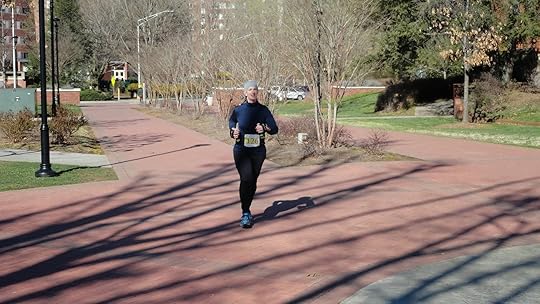 At the finish line!As far as the race itself, few things proved useful as I ran: First, I used my Heart Q heart rate monitor and watch to help determine pace. The race was simply too long, the crowd simply too confusing, my mind simply too amped, to leave 13.1 miles of pacing up to "feel" alone. I'm glad I made that decision.
At the finish line!As far as the race itself, few things proved useful as I ran: First, I used my Heart Q heart rate monitor and watch to help determine pace. The race was simply too long, the crowd simply too confusing, my mind simply too amped, to leave 13.1 miles of pacing up to "feel" alone. I'm glad I made that decision.Second, I mentally guided myself through the race with the quote, "Run the mile you're in." The first time I read that in Runner's World magazine, I scoffed. Only later, after toying with the mantra in my mind for miles at a time, did I come to see the value in it. This mantra got me through some miles I might have otherwise run slowly, by convincing me that there was no need to slow down. More importantly, it got me through the big hills without sapping my spirit by convincing me that I was doing the best I could for that mile, that hill, that moment.
Third, I ran with my Amphipod 12-ounce handheld sports bottles (drink of choice: Gatorade Lemon-Lime). There were Gatorade and water stations every two miles along the course, but I hadn't trained with those and was worried about lines and confusion. Once I got past the first few stations, I was thrilled to have my own Gatorade supply at my fingertips. The flurry to grab a cup and consume, the rush to throw it away, and the confusion of which cup had water and which had Gatorade were all concerns I didn't get caught up in...I just ran on past, sipping from my own supply when needed.
Will I race again? YES. For now, the 5-week countdown to me and Brad's wedding is on, and my triceps and calf muscles have been neglected for six months. I'm ready for less pounding the trail and more "shredding it" with Jillian Michaels. I'll run when I want to, at whatever pace I want, for however long. In between, I'll firm up and count down to the big day!
Published on March 31, 2015 05:00
March 27, 2015
If You Want to Be a Writer
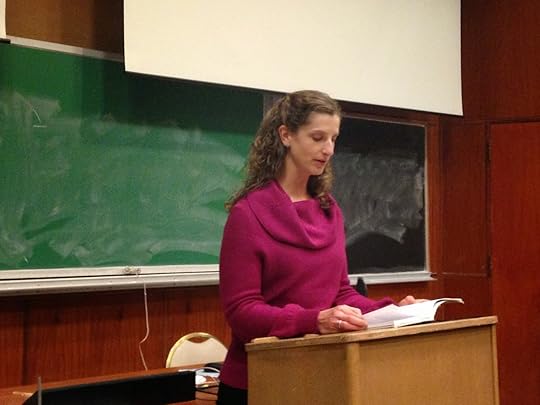 At SUNY Binghamton, I had the opportunity to meet with a class of graduate and undergradute students who studied Flashes of War. This unique class meets only 5 times over the course of semester, sessions lasting 2 hours each time the English Department hosts a visiting author. The students come from across the board--I met Enlish majors, writing majors, biology students, a linguistics major, and a pre-med student, among others. These students also attend the visiting author readings, and I imagine they write some sort of academic or creative response to what they learn from each visit.
At SUNY Binghamton, I had the opportunity to meet with a class of graduate and undergradute students who studied Flashes of War. This unique class meets only 5 times over the course of semester, sessions lasting 2 hours each time the English Department hosts a visiting author. The students come from across the board--I met Enlish majors, writing majors, biology students, a linguistics major, and a pre-med student, among others. These students also attend the visiting author readings, and I imagine they write some sort of academic or creative response to what they learn from each visit.In order to prepare, I was asked to brainstorm "important things you should know if you want to be a writer." The suggestion both excited and humbled me. My first thought was that I don't have anything to say to budding writers. They have to learn it for themselves and I'm still learning many, many things. But I knew an answer like that wouldn't fly, and certainly wasn't what I was being paid for! I spent some time with my journal while on the plane en route to upstate New York, and here's the list I came up with:
Read like a writer: Read widely, but read like a writer. Learn how to put on your X-ray glasses for each sentence, each paragraph. Identify the bones (the structure) of a piece and ask yourself critical questions as you go along. How did the writer achieve that impact? Why did the writer choose to shape the piece in this way?Don't settle for easy answers: Live a full life and don't settle for easy answers. Black and white never makes a good story. Gray--the in-between, the uncertainty--always does. Remember that where there's a question, there's a story. Which questions should you try to answer? The ones where you feel the most genuine curiosity. The ones that keep you up at night. The ones that won't leave you alone until you weave narrative together and land on something true.Remain disciplined: Discipline, more than talent, contributes to your success as a writer. Talent and luck come in at a close second. These are things beyond your control. But that #1--discipline, discipline, discipline--is all yours. Own it.Become obsessive: Indulge yourself in getting lost in the heat and focus of an activity, a concept, a theme, a hobby, or an idea. From running to biking to polka dancing to the archives of the Smithsonian--whatever it is, you've got to have something in your life that exercises the muscle of becoming utterly focused and present. For many years, my obsession was waitressing. Then martial arts. Now running. Think of a soccer player dribbling downfield with a speedy defender at her back. Think of a ballerina, mid-leap. There is no before and after. There is only focus, in the moment. It's that feeling a writer needs to nurture over and over, because it's the same feeling that works in our favor when we're at the desk, too.Be protective: Know how to identify what feeds your imagination and be protective of it. Understand the factors that balance your life, and keep that balance in check. Living a balanced, imaginative life is as much the work of the writer as the words themselves.Hone your perspective: Writing has as much to do with learning how to think and learning how to see, as it does the actual words you put on the page. Nurture these skills. Work with them. Devote your life to them. Where one person sees a daffodil slumped in a patch of flowers, another sees a poem, a story, a memory from the past. Understand what filter your perspective applies to the world and work that into your writing. Then...Know your blindspots: ...look beyond that filter. Look at your blindspots. What have you forgotten? What aren't you seeing? Be vigilant. Learn to see what's hiding and let it light up the page.
Published on March 27, 2015 05:00



